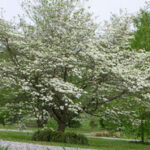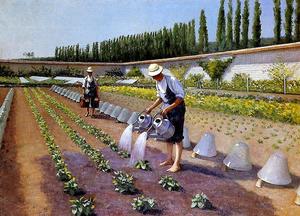Dogwood Trees are known for their delicate early spring blooms in pink or white. Found as an understory tree in forests, it does equally well in the home landscape in full sun. The problem is the dogwood is susceptible to a number of diseases. Here are the more major ones and their symptoms to watch for.
Dogwood Anthracnose
Dogwood Anthracnose is a fungal disease that is believed to have originated in the 1970’s. Spots with a beige center and purplish edge appear on leaves shortly after they break in mid to late May. Check the underside of the leaves for black lesions. The flowers or bracts can also be affected. Watch for reddish brown spots. As the disease progresses, leaves may begin to brown and wilt. The fungus can then move through the leaf stem causing cankers. The disease moves from branch to branch, usually in an upward motion, killing the branches as it goes. Older trees are at risk of death within 1 to 3 years of infection while saplings usually die the first year.
Crown Canker of Dogwood
Crown Canker of Dogwood, or collar rot as it is commonly called, is also known scientifically as Phytophthora cactorum. A scant amount of leaves and bracts, a lighter than usual coloring of the foliage during summer and premature yellowing and drop of the leaves in the autumn are the early signs. During drought, the dogwood develops an exaggerated case of wilt. The branches and twigs start to die back. Just above ground level, a canker develops on the trunk which destroys the bark. Occasionally, seepage from the canker appears before the lesion does. Upon inspection, the bark will be found to be loose and the wood beneath discolored. The disease advances and the canker grows causing more damage to the tree and making it more susceptible to attack from other pests.
Micronutrient Chlorosis
Several micronutrients are required for most plants to be healthy, manganese, zinc and iron. In acidic soils where the pH is 6.5 or higher, these nutrients may not be readily available to plants. If leaves yellow or take on a light green coloration of leaves it may be a sign of micronutrient deficiency. As the leaf changes color, the veins stay green. New growth later in the season will have more pronounced discoloration.
Any number of fungi can cause powdery mildew, a white to gray powdery-looking film on foliage. Periods of high humidity seem to make the outbreak more prevalent. Often appearing later in the growing season, foliage can become disfigured and stunted with severe cases causing premature leaf drop. As available nutrients are diminished in diseased tissue, the tree’s health overall will be adversely affected.
Sooty Mold
Sooty mold is the result of an insect infestation, commonly aphids. They secrete a honeydew liquid which collects on the foliage of the dogwood. Sooty mold spores stick to the honey dew and use it as a growing medium. A black film spreads over the leaves and prevents the leaf from being able to photosynthesize and produce food. Dense insect populations can spread the disease throughout the tree causing severe damage or death.
Sources: Cornell University: Dogwood Disease Fact Sheet
College of Agriculture & Life Sciences: Plat Pathology
University of Georgia: Dogwood Diseases and Problems






